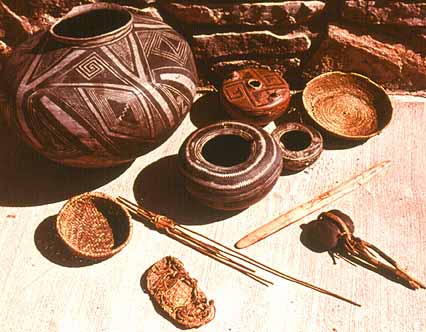The ancient Pueblo people constructed sandals from yucca, hemp weed, hair and other fibers by weaving them on large, upright loom frames. Soles for sandals and moccasins were made of rawhide. Moccasins were constructed of deerskin and sewn with sinew. Matted fibers from juniper bark, which has soft fibers that separate and can be peeled from the bark, were used to insulate sandals and moccasins in cold weather. Fresh goatskins with the hairy side turned inward were worn to encase the feet in snowy weather. Brand new moccasins, sandals or thongs were placed on the dead before burial.
Pueblo women wore a garment made of hundreds of yucca fiber strands covering the buttocks, similar to a beech cloth flap. The men didn't wear much clothing in warm weather except for a belt of woven hair and grasses, necessary to hang tools and items they may need for hands-free hunting and weaving. When sheep were introduced into the villages of the Pueblo people, they began weaving wool for clothing, and years later, cotton for clothing, which was much cooler in warm weather.
Pueblo people enjoyed decorative jewelry. They constructed them out of stone beads, seeds, feathers, coral, bones, shells, abalone and stones. Items were polished, punched, carved and engraved to create jewelry of almost every kind, such as bracelets, arm bands, earrings, necklaces, pins and ankle bracelets for both men and women. Jewelry was often placed in graves with the dead, along with pottery created especially for the burial ceremony. After the Pueblos learned silversmithing from the Spaniards in the 1800s, metal jewelry was integrated into the jewelry materials they were previously using.

The Ancestral Puebloans are also known for their unique style of pottery, today considered valuable for their rarity. They also created many petroglyphs and pictographs. From Ellie Crystal